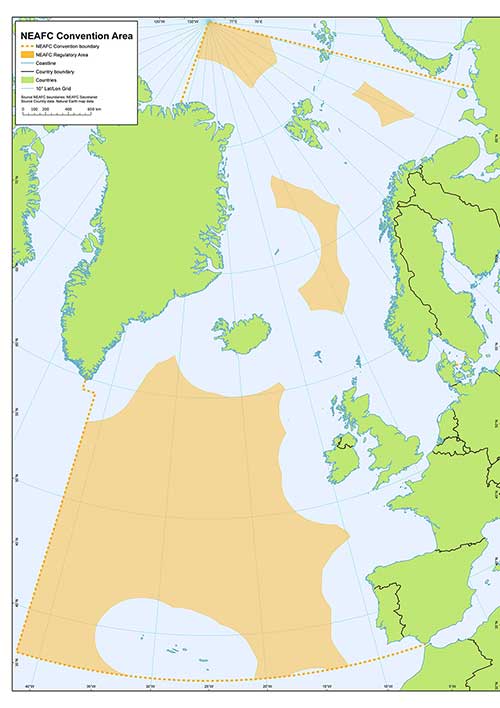Jurisdictional framework
Area of Competence: NEAFC Convention Area
Mandate: Management; Monitoring; Control and surveillance.
 |
NEAFC Convention Area. Courtesy of NEAFC  |
The NEAFC Convention, including its recent amendments, and the documents adopted to deal with specific issues, such as the ‘Measures to Promote Compliance by Non-Contracting Party Fishing Vessels’ (Annex VII of the Scheme of Control and Enforcement – SCE) or the ‘Port States Control Measures’ (Annex V of the SCE) generally implement (and often predate) the global instruments dealing with fisheries issues, in particular the UN Fish Stocks Agreement, the FAO Compliance Agreement, the FAO Code of Conduct and the FAO Port States Measures Agreement. NEAFC is a regional framework Convention and as such its provisions do not fully reflect the details and broad range of issues covered by global regimes, both because of the regional specificities of the NEAFC Convention Area and because, by referring to these instruments in its preamble, it can be assumed that the context within which the general provisions of the NEAFC Convention are to be implemented is that set out in such global instruments.
Responsibilities of the CommissionThe Convention empowers NEAFC to adopt fisheries management recommendations by qualified majority vote (subject to the objection procedure and dispute resolution procedures). Recommendations become binding on Contracting Parties once objection periods expire and Article 15 of the Convention requires the Parties to give effect to these recommendations.
The Commission has established a number of Permanent Committees and Working Groups to assist it in carrying out its responsibilities pursuant to Article 3, paragraph 8 of the Convention. The Commission is also supported by a Secretariat.
Management Strategies
Management scenariosArticles 5 and Article 6 of the Convention set up two scenarios for the management of NEAFC fisheries. Article 5 provides for recommendations for straddling stocks in waters beyond the areas under the jurisdiction of Contracting Parties. Article 6 allows for recommendations that apply to waters under the fisheries jurisdiction of Contracting Parties. This is done at the request of the Contracting Party in question and a recommendation must receive its affirmative vote.
The Contracting Parties of NEAFC have utilised both of these scenarios as follows (see also Management Method section):
It should be noted that, outside the NEAFC framework, relevant Coastal State groups adopt management measures and allocations for the whole distribution area of the relevant fish stocks; this is then the context within which proposals come forward for measures to be adopted by NEAFC for areas beyond the jurisdiction of Contracting Parties (i.e. the Regulatory Area).
Related Fisheries Management Units:
Pelagic Fisheries for the smaller pelagic species
Demersal trawl fisheries for Rockall haddock
Deep sea fisheries (including some prohibitions on targeted fisheries)
Pelagic deep sea redfish fisheries
NEAFC adopts management measures and allocations for the whole distribution area of the stock for areas inside and beyond the jurisdiction of Contracting Parties. Related Fisheries Management Units are:
Some fisheries are regulated fully by arrangements outside the NEAFC context. Examples are the demersal fisheries in the Barents Sea (Joint Norwegian - Russian Fisheries Commission).
Vulnerable Marine EcosystemsIn 2008, NEAFC adopted a new binding Recommendation on bottom fishing which was a comprehensive measure, incorporating all the relevant elements from the UN General Assembly resolution, and the work within FAO. This remains NEAFC’s general approach to the protection of VMEs, although further improvements have been implemented since. Since 2008, the Recommendation 19 : 2014 on area management measures for the protection of vulnerable marine ecosystems in the NEAFC Regulatory Area has been amended several times and the current Recommendation 19 : 2014 (
Rec. 19: 2014 as amended.pdf) includes a rule that regular bottom fisheries could only take place in areas that are defined as “existing bottom fishing areas”, on the basis of actual fishing taking place there within a specific reference period (1987-2007). Outside these areas, in the
restricted bottom fishing areas only exploratory bottom fisheries can be authorised, and these are subject to severe restrictions, including assessment of likely impacts on VMEs.
Source of scientific adviceNEAFC management decisions are informed by independent high quality science. NEAFC does not carry out its own scientific research. Under the NEAFC Convention of 1982, NEAFC seeks the services of the International Council for the Exploration of the Sea for scientific advice on conservation, protection and sustainable use of the marine environment and on fisheries resources management and related matters. NEAFC provides a forum for consultation and exchange of information on the state of fishery resources in the Convention Area as advised by the International Council for Exploration of the Seas (ICES) and then proceeds to agree fisheries management policies, including examination of the overall effect of such policies on other living marine resources and marine ecosystems. Following its most recent Performance Review, the NEAFC Commission agreed in 2015 “that the clear separation between the scientific role of ICES and the policy and management role of NEAFC should be maintained. NEAFC should not take any action that would blur this separation, such as carrying out its own scientific work or doing its own assessment of the scientific advice from ICES.” Steps taken to improve cooperation between NEAFC and ICES have included discussions on long-term development of advice, such as possible multispecies advice, possible climate effects and other ecosystem considerations. Complementary changes have also been made to the Terms of Reference of NEAFC’s Permanent Committee on Management and Science.
The process of receiving advice from ICES on these issues continues. Each year NEAFC receives advice from ICES, not only on the main commercial stocks, but further advice on specific stocks or categories of stocks may be given (e.g. deep sea species or sharks and rays). Advice on Vulnerable Marine Ecosystems is also given each year. This includes information on encounters with, for instance cold water corals and sponges and specific advice on whether existing VME related bottom fisheries enclosures should remain as they are or be amended.





